Papers by Siegfried Wolffram

Journal of Dairy Science, 1998
In monogastric species, a considerable portion of amino acid nitrogen is absorbed across the brus... more In monogastric species, a considerable portion of amino acid nitrogen is absorbed across the brush-border membrane of the small intestine as small peptides (e.g., tripeptides and dipeptides). In ruminants, however, this process is less clear. Therefore, we investigated the uptake of radioactively labeled glycylsarcosine as a model dipeptide across the intestinal brush-border membrane using brush-border membrane vesicles prepared from the bovine small intestine. Uphill transport of glycylsarcosine was energized by a transmembrane H+ gradient and was further stimulated by an electrical potential difference across the membrane. Transport mediated by a carrier contributes to total glycylsarcosine transport across the brush-border membrane. Comparison of the apparent kinetic constants between brush-border membranes prepared from the proximal jejunum or ileum revealed similar half-saturating substrate concentrations (1.28 and 0.93 mmol/L for proximal jejunum and ileum, respectively), but maximal transport rates appeared to be somewhat higher in the proximal small intestine (2.15 and 1.20 nmol/mg of protein per 3 s for proximal jejunum and ileum, respectively). Uptake of glycylsarcosine was strongly inhibited by other dipeptides, but the amino acids glycine and sarcosine did not affect transport. Inhibition of glycylsarcosine uptake by cephalexin indicated an affinity of the carrier for cephalosporin antibiotics. Transport of intact dipeptides across the brush-border membrane of the small intestine might be of physiological importance in ruminants because the microbial and dietary proteins resistant to rumen degradation are digested and absorbed in the small intestine.
Oxidative Stress and Disease, 2004

Mycotoxin research, 2005
The mycotoxin ochratoxin A (OA) is regarded as a causative agent for endemic nephropathy in farm ... more The mycotoxin ochratoxin A (OA) is regarded as a causative agent for endemic nephropathy in farm animals and humans. Reabsorption of OA along the nephron results from nonionic diffusion and by carrier-mediated mechanisms indicating that urine alkalinization may help to accelerate OA excretion and thus reduce its toxicity. The aim of the present study was to investigate the effect of a dietary sodium bicarbonate (NaHCO3) supplementation as a means to increase urinary pH on the systemic availability and excretion of OA in pigs. Dietary supplementation of 2% NaHCO3 increased urinary pH (5.7±0.2 to 8.3±0.1) and daily urine volume (1108±276 to 2479±912ml) significantly. The systemic availability of OA and its dechloro-analog Ochratoxin B (OB) in the NaHCO3 group calculated as the area under the serum concentration-time curve (AUC) was reduced to 75 and 68%, respectively, of the control (P<0.05). This effect was mainly due to an accelerated elimination of OA and OB in the urine. The fa...
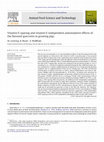
Animal Feed Science and Technology, 2011
The aim was to investigate in vivo the antioxidative effects of the flavonol quercetin with speci... more The aim was to investigate in vivo the antioxidative effects of the flavonol quercetin with special emphasis on interactions with vitamin E (␣TOC) in growing pigs. It was assumed that any effects of quercetin on the antioxidant status would be more pronounced at low ␣TOC intake and that feeding diets with the addition of fish oil would induce an oxidative stress under these conditions. After a 5 week depletion period, in which all pigs (n = 26) were fed a low ␣TOC (7 mg/kg) diet, animals were assigned to one of 4 dietary groups (n = 6 or 7) according to a 2 × 2 factorial completely randomized design for four additional weeks. Factors consisted of (1) dietary supplementation of quercetin (0 or 10 mg quercetin/kg body weight/d) and (2) supplementation of fish oil (0 or 50 g/kg diet). The ␣TOC and flavonol concentrations in plasma and tissue as well as plasma thiobarbituric acid reactive substances (TBARS) and 8-iso-prostaglandin-F 2␣ (8-iso-PGF 2␣) in plasma were measured. At low vitamin E intake, supplementation of quercetin tended to elevate plasma (0.42 vs. 0.54 g/mL; P=0.063) and liver (0.16 vs. 0.24 g/g; P=0.06) ␣TOC concentrations with no influence on the concentrations of markers of lipid peroxidation (TBARS, 8-iso-PGF 2␣), indicating a ␣TOC-sparing effect of quercetin. An additional ␣TOC-independent antioxidative effect of quercetin was not obvious under these conditions. However, further challenging the antioxidative mechanisms by the addition of fish oil at low ␣TOC intake resulted in a further reduction (P<0.05) of ␣TOC concentration in plasma (0.65 vs. 0.31 g/mL) which could not be prevented by quercetin at least at the dose fed. However, the concomittant increase in lipid peroxidation indicated by elevated (P<0.05) concentrations of TBARS and 8-iso-PGF 2␣ was ameliorated (P<0.05) by quercetin, suggesting a ␣TOC-independent antioxidative effect. Taken together, depending on the ␣TOC status, quercetin revealed a ␣TOC-sparing as well as ␣TOC-independent antioxidative effect at low ␣TOC intake.
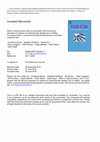
Nutrition, 2019
This is a PDF file of an unedited manuscript that has been accepted for publication. As a service... more This is a PDF file of an unedited manuscript that has been accepted for publication. As a service to our customers we are providing this early version of the manuscript. The manuscript will undergo copyediting, typesetting, and review of the resulting proof before it is published in its final form. Please note that during the production process errors may be discovered which could affect the content, and all legal disclaimers that apply to the journal pertain. Highlights ALA on a daily basis improved lipid profiles in healthy, non-obese men and women No evidence of a synergistic effect of ALA plus quercetin on CVD risk markers Regular intake of supra-nutritional doses of quercetin increased plasma quercetin Effect of alpha-linolenic acid in combination with the flavonol quercetin on markers of cardiovascular disease risk in healthy, non-obese adults: a randomized doubleblinded placebo-controlled crossover trial
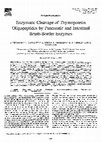
Peptides, 1996
testinal enzymatic degradationof the immunomodulatingpeptides thymotrinan(TP3), thymocartin (TP4)... more testinal enzymatic degradationof the immunomodulatingpeptides thymotrinan(TP3), thymocartin (TP4), and thymopentin (TP5), three oligopeptidesderivedfrom the naturallyoccurringthymushormonethymopoietin,was investigatedto evaluatetheir potentirdfor peroral drug delivery.In the presenceof brush-bordermembranevesicles, crude pancreas extract and everted rings from duodenum, jejunum,ileum,and colon,all peptideswere shownto be degradedbothby pancreaticenzymesand brush-border aminopeptidases. Degradationclearances (C&) of TP3, TP4, and TP5 were crdculatedfor a quantitativecomparisonof peptide stability.In the presence of crudepancreas extract, there was a rapid degradationof TP5 (Cl~.g17.9rnlhnin) in comparisonwith TP3 and TP4 (CL, 0.95 and 0.56 ml/min, respectively,at 0.2 mkf peptide concentration)caused by the cleavage of the Cterminal tyrosineby carboxypeptidaseA, whereasTP3 and TP4 underwenthydrolysisby arninopeptidaseN. In the presence of brush-bordermembranevesicles,the degradationclearanceswere 3.9,3.1, and 2.4 mlhnin at 0.2 mkf concentrationsof TP4,TP5, and TP3, respectively.The clearance of all peptides was lowered with increasing peptide concentrations,indicating saturable degradationprocesses. The degradationof the thymopoietinoligopeptidesin the presence of brush-bordermembraneenzymes was exclusivelycatalyzedby aminopeptidaseN. The degradationof all peptideswas highlydependenton the intestinal segmenL with the lowest degradationclearance observedin the colon. Copyright01996 ElsevierScienceInc.
SAT Schweizer Archiv für Tierheilkunde
ABSTRACT

Journal of Equine Veterinary Science, 2015
Quercetin is a plant-derived flavonoid with strong anti-inflammatory properties. Previ- ously, sy... more Quercetin is a plant-derived flavonoid with strong anti-inflammatory properties. Previ- ously, systemic availability of quercetin was documented in horses. We investigated effects of a daily quercetin supplementation on plasma concentrations of quercetin and its me- tabolites over two weeks. Additionally, plasma concentrations of selected proinflammatory and anti-inflammatory cytokines were analyzed before and immediately after the exper- iment. Four adult Warmblood horses with a mean body weightstandard error of the mean of 551 � 46 kg were used. During a two-week pre-experimental phase and also during the experiment, the use of dietary supplements, apples, or any form of medication was excluded; the horses were offered hay ad libitum, concentrated feed individually (7 AM and PM), and 8 hours access to pasture. During the experiment, quercetin (10 mg/kg body weight) was administrated within the evening meals. Blood samples were collected (jugular vein) three times during the pre-experimental phase and on days 4, 8, 11, and 14 after the start of the experiment. Flavonols in plasma and feed were analyzed by high- performance liquid chromatography; plasma concentrations of cytokines were measured using commercial enzyme-linked immunosorbent assay kits. Daily quercetin supple- mentations for two weeks increased kaempferol and thus total plasma flavonol concen- trations time dependently without accumulation of quercetin or its methylated metabolite isorhamnetin. Although proinflammatory cytokines stayed below detection limit, plasma concentrations of anti-inflammatory cytokines (interleukin-10, interleukin-1 receptor antagonist) were enhanced by quercetin feeding. The study indicates that dietary quer- cetin supplementation moderately induces total plasma flavonols and thus may be useful in controlling inflammatory disorders in horses. However, anti-inflammatory effects of quercetin must be confirmed in controlled trials.
Journal of Investigative Dermatology, 2009
Treatment of severe psoriasis with fumaric acid esters: scientific background and guidelines for ... more Treatment of severe psoriasis with fumaric acid esters: scientific background and guidelines for therapeutic use. The German Fumaric Acid Ester Consensus Conference. Br J Dermatol 141:424-9
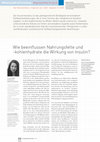
In der Pathogenese der Insulinresistenz sind solche Störungen von besonderer Relevanz, die die in... more In der Pathogenese der Insulinresistenz sind solche Störungen von besonderer Relevanz, die die intrazelluläre Signalkaskade betreffen, welche durch die Bindung von Insulin an den Insulinrezeptor ausgelöst wird [1]. Ist beispielsweise der über den so genannten Phosphatidylinositol-3’-kinase(PI3K)-Weg gesteuerte Einbau des Glukosetransporters Typ 4 (GLUT4) in die Zellmembran gestört, kann Insulin seine blutglukosesenkende Wirkung aufgrund der nicht gesteigerten Aufnahmekapazität für Glukose im weißen Fettgewebe und Skelettmuskel nicht vollständig entfalten [2]. Dies bedingt wiederum einen Anstieg der Blutglukosekonzentration. Besteht die Störung über einen längeren Zeitraum, kann es zu erheblichen Gewebeschädigungen, insbesondere der Nerven und Blutge fäße kommen. Häufig wird aufgrund des Fehlens klarer Symptome das frühe Stadium der Erkrankung nicht erkannt, was zur Folge hat, dass fast die Hälfte aller Be troffenen nicht wissen, dass sie an einer lebensbedrohlichen Krankheit leiden ...
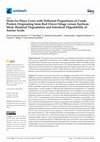
Animals
The purpose was to assess the effect of exchanging crude protein (CP) of soybean meal (SBM) with ... more The purpose was to assess the effect of exchanging crude protein (CP) of soybean meal (SBM) with red clover silage (RCS) in total mixed rations (TMR) on ruminal degradation and intestinal digestibility (ID) of essential amino acids (EAA). Four TMR and their individual feed components were studied. The TMR were composed of forage and concentrates (75:25), with proportions of RCS in TMR of 0.15, 0.30, 0.45, and 0.60 on a dry matter basis, resulting in diet groups RCS15, RCS30, RCS45, and RCS60, respectively. The ruminal degradation of EAA was determined using the nylon bag technique. For this, samples of TMR and their individual feed components were ruminally incubated for 16 h. The feed residues of TMR obtained after 16 h of incubation were used for the determination of ID of EAA using the mobile-bag technique. Increasing RCS and reducing SBM proportions linearly increased (p < 0.01) the in situ ruminal degradation of individual EAA from 75.5% to 83.5%. The degradation of EAA foll...

Animals
Methane emissions from ruminants are a major contributor to agricultural greenhouse gas emissions... more Methane emissions from ruminants are a major contributor to agricultural greenhouse gas emissions. Thus, eight different forage species were combined in binary mixtures with Lolium perenne in increasing proportions, in vitro, to determine their methane reduction potential in ruminants. Species were sampled in two consecutive years where possible. The aims were: a) to determine if mixtures with specific forages, particularly those rich in plant specialized metabolites (PSM), can reduce methane emissions compared to ryegrass monocultures, b) to identify whether there is a linear-dose effect relationship in methane emissions from the legume or herb addition, and c) whether these effects are maintained across sampling years. Results showed that all dicot species studied, including the non-tannin-containing species, reduced methane production. The tannin-rich species, Sanguisorba minor and Lotus pedunculatus, showed the greatest methane reduction potential of up to 33%. Due to concomitan...
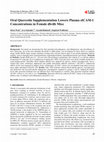
Pharmacology & Pharmacy, 2013
Background: Flavonoids are documented for their potential anti-adipogenic, anti-inflammatory and ... more Background: Flavonoids are documented for their potential anti-adipogenic, anti-inflammatory and anti-diabetic effects. Quercetin, one of the most abundant flavonoids in edible plants, was investigated for these effects in a diabetic mouse model (db/db, leptin receptor mutation) exerting early relevant clinical signs of non-insulin dependent diabetes mellitus, such as hyperglycemia, hyperinsulinemia, hypertriglyceridemia, hypoadiponectinemia and obesity. Materials & Methods: Female db/db mice (n = 24) were fed a flavonoid-poor maintenance diet without (C) or with the addition of quercetin (0.3 g/kg diet, Q) or rosiglitazone (4 mg/kg diet, TZD). Food and water were freely available during the 4 week feeding period. Thereafter, blood samples (fasted) were analyzed for glucose, insulin, triacylglycerols, non-esterified fatty acids, cholesterol, adiponectin and soluble intercellular adhesion molecule-1 (sICAM-1). Adiponectin mRNA levels were measured in adipose tissue. Furthermore, sICAM-1 release was investigated using tumor necrosis factor alpha stimulated EAhy926 cells. Results: Only TZD treatment reduced fasted plasma glucose, triacylglycerols and cholesterol and increased plasma adiponectin concentrations compared to groups C and Q. Adiponectin mRNA levels after quercetin treatment were not different from TZD-treatment or controls. Only quercetin treatment reduced sICAM-1 release in vitro and in vivo. Conclusions: Quercetin effectively reduced sICAM-1 release in the progressive diabetic state, revealing its anti-inflammatory potential in vivo.

European Journal of Pharmaceutical Sciences, 2009
The influence of the dietary flavonol quercetin on the pharmacokinetics of the HMG-CoA reductase ... more The influence of the dietary flavonol quercetin on the pharmacokinetics of the HMG-CoA reductase inhibitor simvastatin was investigated in pigs. Simvastatin (0.25mg/kg body weight) was orally administered to six pigs either without or with quercetin (10mg/kg). In addition, simvastatin was administered to three pigs that had received a diet supplemented with the flavonol over a period of 1 week. Daily quercetin intake was 10mg/kg in these animals. Co-ingestion of quercetin with the statin did not alter area under the concentration time curve (AUC(0--&amp;amp;amp;amp;amp;amp;amp;amp;amp;amp;amp;amp;amp;amp;amp;amp;amp;amp;amp;amp;amp;amp;amp;amp;amp;amp;amp;amp;gt;infinity)), time to achieve maximum plasma concentration (t(max)) or half-life (t(1/2)) of simvastatin. However, there was a trend towards a reduction of the maximum plasma concentration (C(max)) of simvastatin when quercetin was administered concomitantly (P=0.06). As compared to controls, AUC(0--&amp;amp;amp;amp;amp;amp;amp;amp;amp;amp;amp;amp;amp;amp;amp;amp;amp;amp;amp;amp;amp;amp;amp;amp;amp;amp;amp;amp;gt;infinity) of simvastatin was significantly decreased after feeding the quercetin-supplemented diet for 1 week. The plasma ratio of simvastatin and its acid metabolite was neither altered by the concomitant quercetin ingestion nor by feeding of the flavonol over a period of 1 week. We conclude that chronic ingestion of high doses of the flavonol quercetin will decrease the bioavailability of simvastatin to a significant extent.

European Journal of Nutrition, 2013
To investigate the influence of dietary proteins (casein, soy protein) and skimmed milk on the pl... more To investigate the influence of dietary proteins (casein, soy protein) and skimmed milk on the plasma kinetics of green tea (GT) catechins. In a randomized cross-over design with one-week intervals, 24 healthy normal-weight women consumed a test drink containing 1.75 g GT extract with or without the addition of different proteins. Treatments were GT (control), GT with skimmed milk (GT + M), GT with caseinate (GT + CS), or GT with soy protein (GT + S). Venous blood samples were taken before and several times during a period of 4.5 h after consumption of the test drink. Plasma concentrations of catechins were analyzed by HPLC with electrochemical detection. Compared to control, consumption of GT with milk, caseinate, or soy protein significantly reduced the bioavailability (mean area under the plasma concentration-time curve) of total catechins (means ± SEM; GT + M, 87 ± 5%; GT + CS, 79 ± 5%; GT + S, 88 ± 4%), epigallocatechin gallate (GT + M, 68 ± 4%; GT + CS, 63 ± 5%; GT + S, 76 ± 5%), and epicatechin gallate (GT + M, 68 ± 5%; GT + CS, 66 ± 6%; GT + S, 77 ± 6%), while the bioavailability of non-galloylated catechins such as epigallocatechin (GT + M, 134 ± 9%; GT + CS, 118 ± 9 %; GT + S, 123 ± 8%) and epicatechin (GT + M, 125 ± 10%; GT + CS, 114 ± 11%; GT + S, 110 ± 8%) significantly increased. No significant differences in bioavailability of GT catechins were observed between the treatments GT + M, GT + CS, or GT + S. Simultaneous ingestion of dietary proteins reduces the bioavailability of galloylated catechins from GT in humans.
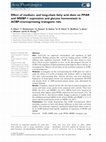
Acta Physiologica, 2008
Aim: Acyl-CoAs are important intermediates and regulators of lipid metabolism. Binding proteins l... more Aim: Acyl-CoAs are important intermediates and regulators of lipid metabolism. Binding proteins like acyl-CoA binding protein (ACBP) can influence their regulatory functions. ACBP has also been shown to exert direct effects on gene regulation in vitro. As the physiological relevance of ACBP in the regulation of lipid metabolism under high fat diets is unclear, we investigated the influence of such diets on the metabolic responses in ACBPoverexpressing rats. Methods: A transgenic rat line overexpressing the ACBP gene was used to study the effects of 4 weeks of feeding with medium-(MC) or long-chain (LC) fatty acid-containing diets. Glucose tolerance tests were performed. Expression of transcription factors was measured by quantitative RT-PCR and protein levels of AMP-activated protein kinase were determined by western blotting. Results: Transgenic animals fed the MC diet had an improved glucose tolerance and lower serum insulin levels compared with controls. Their liver PPARc (by 43%) and SREBP-1 (by 35%) mRNA levels were found to be decreased, while adipose tissue PPARc expression was increased by 31%. Tg animals fed the LC diet did not exhibit changes in glucose or insulin levels but exhibited increased mRNA levels of liver PPARs and SREBP-1 (1.5-3.5 times) and decreased protein levels of AMPKa (by 48%). Conclusions: Our results demonstrate that ACBP overexpression affects metabolic responses to diets with distinct difference in their fatty acid chain lengths. The molecular regulatory mechanism behind these effects seems to be an ACBP-induced tissue-specific regulation of expression of PPARs and SREBP.
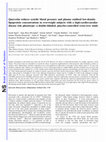
British Journal of Nutrition, 2009
Regular consumption of flavonoids may reduce the risk for CVD. However, the effects of individual... more Regular consumption of flavonoids may reduce the risk for CVD. However, the effects of individual flavonoids, for example, quercetin, remain unclear. The present study was undertaken to examine the effects of quercetin supplementation on blood pressure, lipid metabolism, markers of oxidative stress, inflammation, and body composition in an at-risk population of ninety-three overweight or obese subjects aged 25–65 years with metabolic syndrome traits. Subjects were randomised to receive 150 mg quercetin/d in a double-blinded, placebo-controlled cross-over trial with 6-week treatment periods separated by a 5-week washout period. Mean fasting plasma quercetin concentrations increased from 71 to 269 nmol/l (P < 0·001) during quercetin treatment. In contrast to placebo, quercetin decreased systolic blood pressure (SBP) by 2·6 mmHg (P < 0·01) in the entire study group, by 2·9 mmHg (P < 0·01) in the subgroup of hypertensive subjects and by 3·7 mmHg (P < 0·001) in the subgroup o...
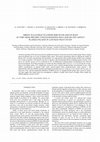
Journal of physiology and pharmacology : an official journal of the Polish Physiological Society, 2009
Green tea catechins (GTC) have been shown to inhibit the activities of enzymes involved in folate... more Green tea catechins (GTC) have been shown to inhibit the activities of enzymes involved in folate uptake. Hence, regular green tea drinkers may be at risk of impaired folate status. The present experiments aimed at studying the impact of dietary GTC on folate concentrations and metabolism. In a human pilot study (parallel design) healthy men consumed for 3 weeks 6 capsules (approximately 670 mg GTC) per day (2 capsules with each principal meal) containing aqueous extracts of the leaves of Camellia sinensis (n=17) or placebo (n=16). No differences in plasma folate concentrations were observed between treatments. We further fed groups of 10 male rats diets fortified with 0, 0.05, 0.5, 1, or 5 g GTC/kg for 6 weeks. Only at the highest intake, GTC significantly decreased serum 5-methyl-tetrahydrofolate concentrations in rats, while mRNA concentrations of reduced folate carrier, proton-coupled folate transporter/heme carrier protein 1, and dihydrofolate reductase (DHFR) remained unchange...











Uploads
Papers by Siegfried Wolffram